The drawings by Louis Nicolas, now collected in the Codex Canadensis, are among the most significant examples of colonial art of New France. Artwork from New France focused almost exclusively on religious subjects and portraits of dignitaries. Nicolas’s art, in contrast, depicts the Indigenous peoples and the plants and animals he observed during his eleven years in the colony. As such, it stands apart from other European representations of North America. Nicolas’s drawings provide a unique resource for art historians and for scholars of natural history.
Attribution of the Codex Canadensis
The drawings and maps in the Codex Canadensis are not signed or dated, and there is no record of where the album was kept for more than two centuries after Nicolas had it bound. Then, in 1930, Maurice Chamonal, a Parisian antiquarian bookseller well known for his interest in Americana, published a facsimile of an old illustrated manuscript called Les Raretés des Indes. The original was an album of ink drawings on paper bound in leather and adorned with gold fleurs-de-lys, indicating that the volume may have been destined for the Royal Library (Bibliothèque du Roi) during the reign of Louis XIV. Nobody knew who had created these curious drawings.
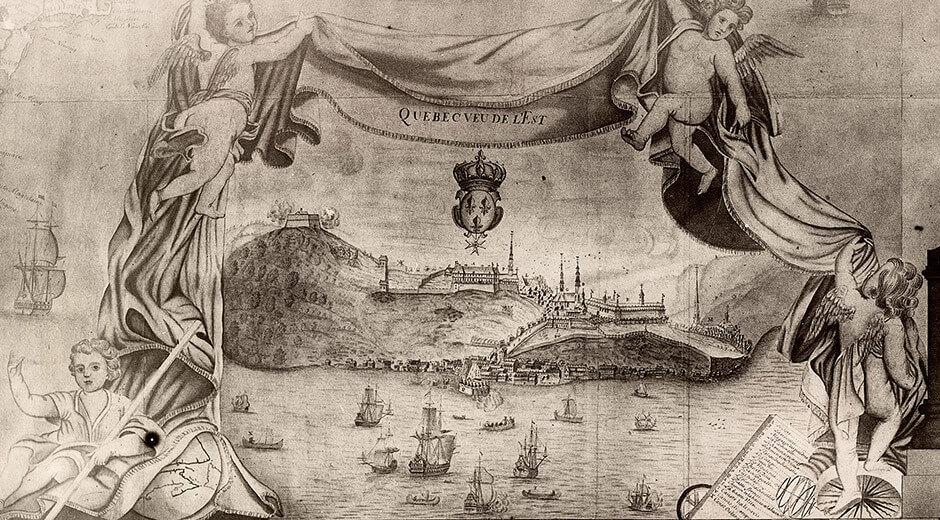
The man who contributed the introductory essay to the 1930 edition, Baron Marc de Villiers, had already written a history of the founding of Louisiana. Based on the maps and the information he deduced from the second dedication in the manuscript (page 2), he dated the book to 1700 and attributed it to Charles Bécart de Granville (1675–1703)—the only person there at the time, he argued, with enough training in cartography to draw the two maps in the album. The best known of the few existing maps by Bécart is his Quebec, View from the East (Québec, vue de l’est) (1699). De Villiers also gave the facsimile volume the title Codex Canadiensis—now corrected to Codex Canadensis, the name it is known by today—even though it was titled Les Raretés des Indes on the spine of the original manuscript volume.
In 1949 the oil baron Thomas Gilcrease bought the original bound manuscript and placed it in his museum—now called the Gilcrease Museum—in Tulsa, Oklahoma. Over the last five decades, scholars in many different disciplines—Renaissance-era natural history, New France religious history, patronage, cartography, paleography, and manuscript study—have researched its origins and concluded that it was produced in France in 1700 at the latest by Louis Nicolas, a Jesuit missionary priest who had served in New France from 1664 to 1675.

The attribution is based on links found in four manuscripts now considered to be by Nicolas: the Algonquin Grammar (Grammaire algonquine), Treatise on Four-footed Animals (Traité des animaux à quatre pieds), The Natural History of the New World (Histoire naturelle des Indes occidentales), and the Codex Canadensis. Although The Natural History and the Codex are taken to be closely related, the few small schematic notations in The Natural History are not sufficient to confirm a common author. Rather, the clues come from the references to the “traité des figures” in this same work, where Nicolas declares several times that he has drawn the figures in the Codex himself.
Nicolas signed what is probably his first work, the Algonquin Grammar, likely in 1672–74, with the initials L.N.P.M., for “Louis Nicolas prêtre missionaire” (Louis Nicolas, Missionary Priest). The Natural History is signed with the initials M.L.N.P.—the same letters but in a slightly different order and with the meaning “Messire Louis Nicolas prêtre,” indicating that he was no longer in the Jesuit Order but a simple parish priest. Based on similarities in the handwriting, scholars have concluded that Nicolas is responsible for both The Natural History and the Codex Canadensis, including the captions. The close correspondence in the content of these two volumes strongly supports that view.
Although the drawings in the Codex Canadensis are not dated, the captions can be traced to the year 1700 (or early 1701). The clue is found in one of the three images dedicated to the French monarchy at the beginning of the manuscript (pages 1 to 3). In the Royal Crown of France (Couronne royalle), n.d., the caption refers to Philip V, the grandson of Louis XIV, as the new king of Spain. He was the first member of the French House of Bourbon to sit on the Spanish throne. Philip’s accession soon provoked a major European conflict, known as the War of Spanish Succession (1701–14), because the other powers feared that the potential union of France and Spain under one monarch would upset the balance of power. There is, however, no mention of this war in the caption. For that reason, Nicolas must have written his commentary of this image late in 1700 or very early in 1701.

It seems that the captions and the page and figure numbers in the Codex were added after the drawings were completed. These items never overlap the images and, when there are multiple images on one page, they fill the gaps between them. The drawings themselves probably belong to the 1690s. The caption for the fine stallion states that it is one of the horses Louis XIV sent to New France “more than thirty years ago.” The horses arrived in 1667, so Nicolas wrote these words in 1697 at the earliest.
Nicolas created the Codex Canadensis as the illustrated companion volume to The Natural History—a book he seems to have begun in the late 1670s, before he left the Jesuit Order, and which he hoped to publish. As he wrote at the beginning of The Natural History: “My God, how I regret embarking on an enterprise as difficult as this one of making an account of the New World, where there are so many things to say.” It is quite possible that he had the leather binding of the Codex stamped with the fleurs-de-lys in the hope that, by presenting it to the royal library, he would attract a favour from the king that would allow him to fulfil his dream for The Natural History.
Nicolas’s Singular Vision
Most of the art Nicolas would have seen in New France was either political (portraits of dignitaries) or religious—whether paintings, sculpture, or church decoration. In light of this fact, Nicolas’s talent as an illustrator of natural history themes stands out as being particularly original and unique for his times.
Only certain pieces of art were created in the colony: the French government, wanting to keep France prosperous and the colony dependent, stipulated that paintings and other objects that were easy to transport should all be created in France and exported across the Atlantic. Sculpture, which was heavy, was an exception, allowing Noël Levasseur (c. 1680–1740) and many members of his family to flourish in Quebec for more than a century.


A few French artist priests created paintings on religious themes during their time in New France. Claude François (Frère Luc, 1614–1685) was the most accomplished, producing a portrait of Bishop François de Laval as well as his best-known work, The Assumption (L’Assomption), 1671, for the Récollet chapel in Quebec (now at the Hôpital Général). Hugues Pommier (1637–1686) also liked to paint, and he may well have been called on to create a posthumous image of Marie de l’Incarnation. The Jesuits Jean Pierron (1631–1700) and Claude Chauchetière (1645–1709) also painted religious scenes used to convert the Indigenous peoples they worked among.
One of the most famous paintings from the period, France Bringing Faith to the Hurons of New France (La France apportant la foi aux Hurons de la Nouvelle-France), c. 1670, was commissioned by the Hurons from a painter (unknown) in France and given to the Jesuits for their new chapel in Quebec. It depicts a Huron kneeling before Anne d’Autriche, the mother of Louis XIV, and presenting a framed painting of the so-called extended Holy Family, including Joachim and Anne, the grandparents of Jesus. A French ship is docked in the bay in the background, surrounded by two small chapels and some highly conventional landscape. Several engravings depicting the Jesuit martyrs Jean de Brébeuf and Gabriel Lalemant at Sainte-Marie among the Hurons were also popular, the most famous by Grégoire Huret (1606–1670).
Life was harsh in the early years of this colony, and the small settler community was preoccupied with survival, trade, and business. Art was a luxury, serving mainly to address the religious needs of French Catholics in New France. Individuals who had survived a severe illness, a storm at sea, or some other danger sometimes gave thanks to God by ordering from an artist a votive painting that depicted the scene—or by making it themselves (the Sainte-Anne-de-Beaupré museum in Quebec holds many of these naïve and often charming images).

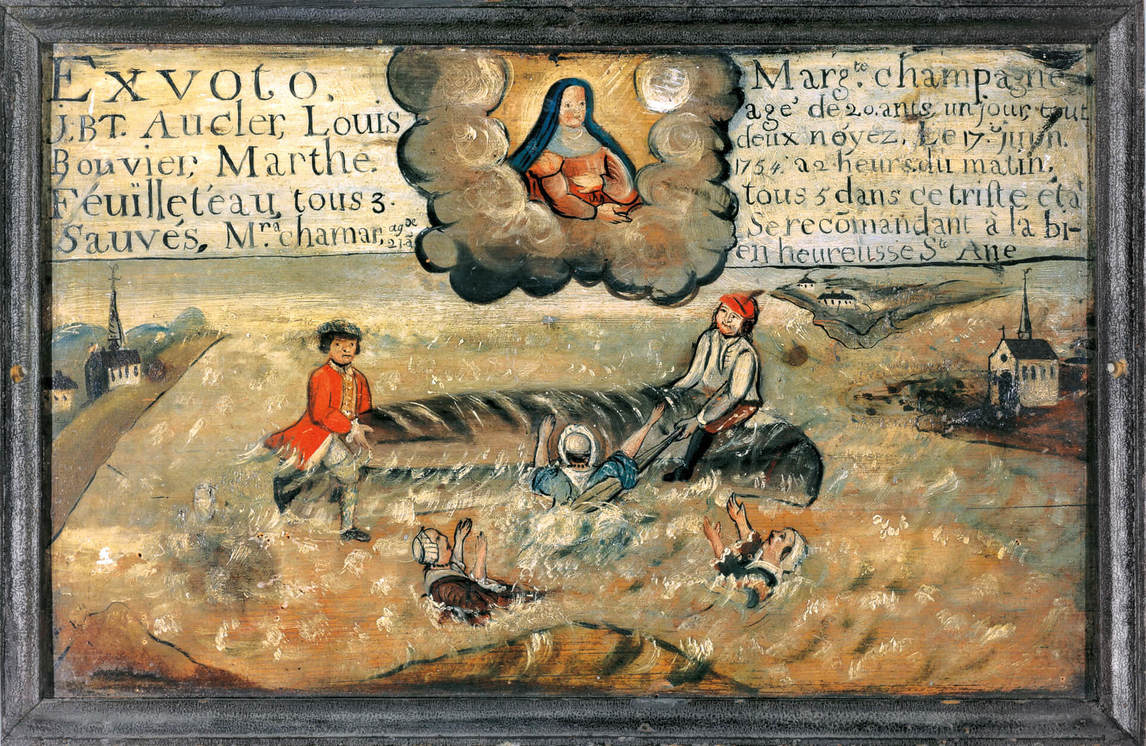
Very few artists or mapmakers gave any thought to recording the natural wonders of this astonishing new country. Louis Nicolas was the exception. He appreciated the novelty of the subject matter all around him and determined to make it known to everyone—from Louis XIV down. As he wrote in The Natural History:
What likelihood is there that, even after twenty years of assiduous work and repeated great travels, I can say all that is necessary about so many fine curiosities of a foreign country, where everything is different from ours? How can I reduce into small space so many vast lands, and speak in few words of so many different objects about which, if I tried to speak thoroughly, I would never finish?
Although Nicolas left New France in 1675, it seems that it was not until the 1680s that he began seriously to record his observations in The Natural History. When he found that words alone were insufficient to fulfill his purpose, he produced a book of drawings, Les Raretés des Indes, known now as the Codex Canadensis, in which he illustrated the same plants and animals he had mentioned in The Natural History. These two volumes should be regarded as different works, but they are strongly enough related for scholars to attribute them to the same author.
The Artist as Naturalist
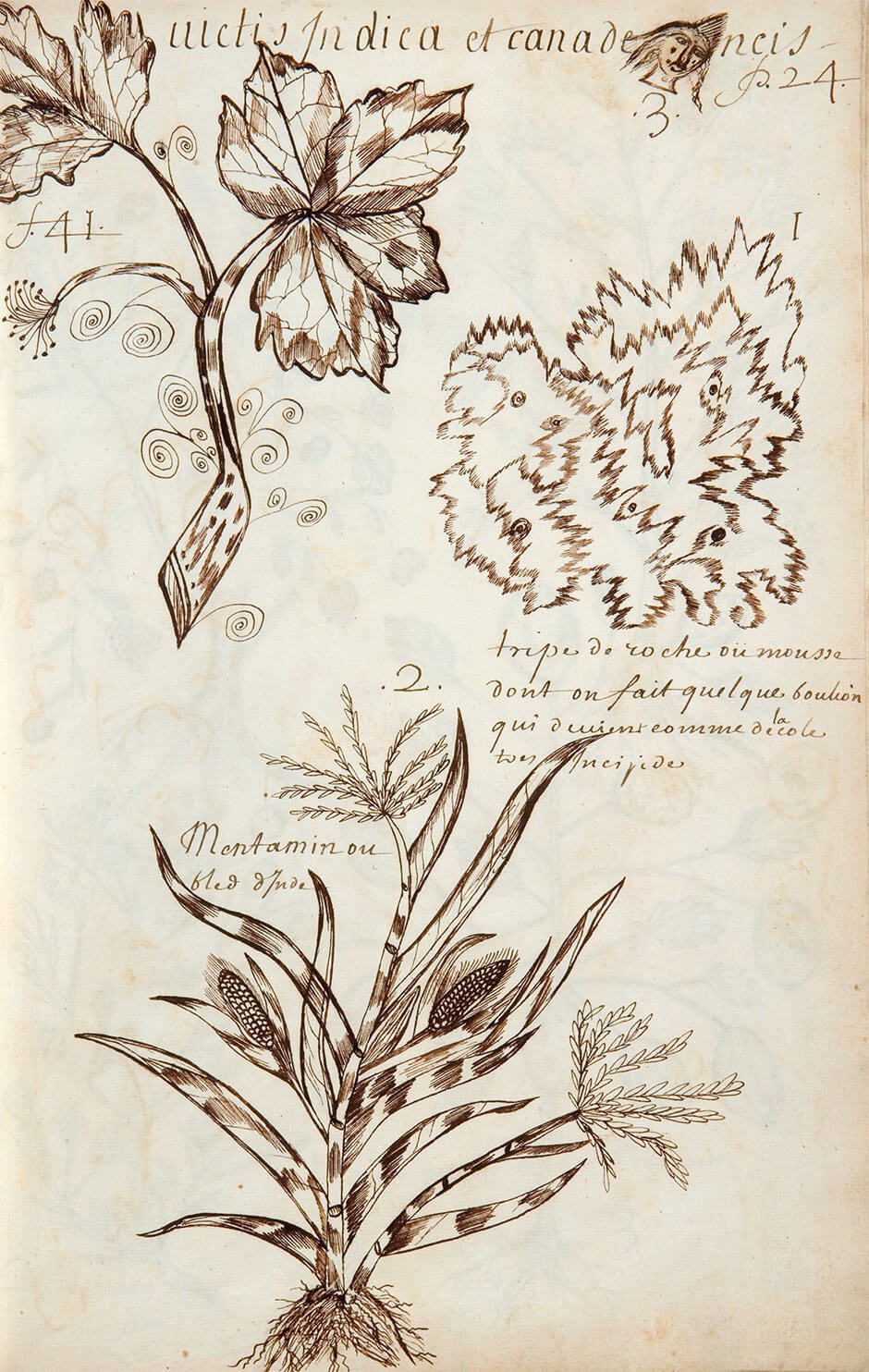
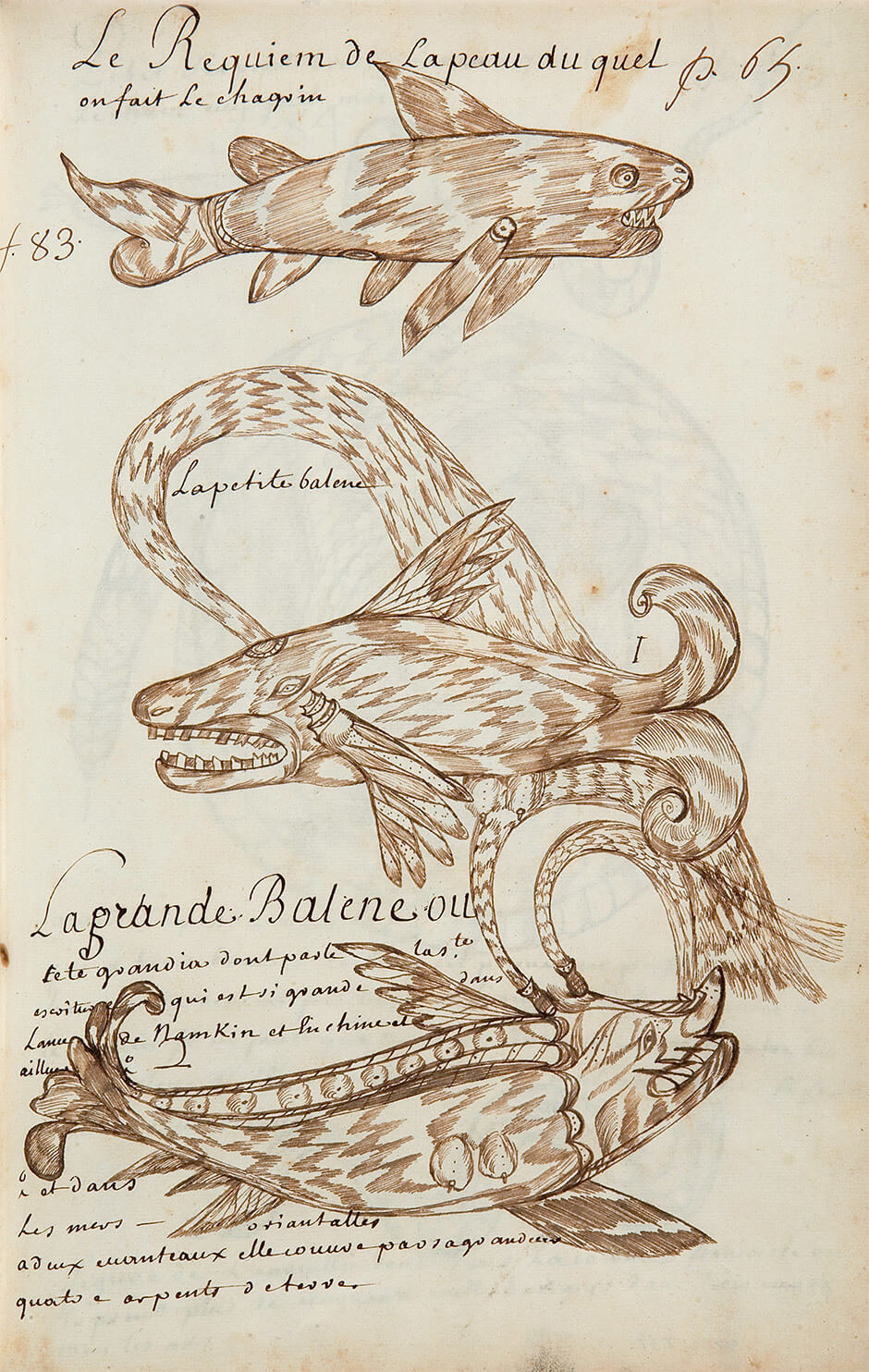
During his eleven years in New France as a missionary priest, from 1664 to 1675, Louis Nicolas travelled extensively. It appears, though, that his main interest was not to convert souls to the Catholic faith but to document the natural history of this land by observing the local inhabitants, plants, animals, birds, insects, and fish he encountered.
The Codex Canadensis, the only illustrated manuscript among Nicolas’s major works, ranks as one of the most significant documents of the late seventeenth century in North America—a work of art that is also an example of graphic scientific reporting. All the plants illustrated in the Codex, except for the passion flower (passiflora), and all the animals, even the Unicorn of the Red Sea (Licorne de La mer rouge), n.d., are mentioned and described in The Natural History. The same is generally true for the mammals, birds, and fish. Sometimes the animals are presented in exactly the same order and described with the same terminology. The only parallel section in the Codex that does not exist in The Natural History is the ethnographic material—the portraits and sketches of Indigenous peoples and their ways of life. Nicolas may well have drafted this material, but it has not yet been found. All told, the seventy-nine-page Codex is illustrated with 180 pen-and-ink drawings on paper, including some with watercolour (or perhaps tempera) tinting.
In the latter seventeenth century, Western Europe and Britain were on the brink of the Enlightenment—a period devoted to intense colonial activity and to discovery and learning about the natural world, the past, and other civilizations. Nicolas, however, lived before the Swedish naturalist Carl Linnaeus (1707–1778), who formalized the modern classification system, and the Jesuit organized his illustrations according to the hierarchy he had learned during his education: first the humans, the highest beings in the natural order; then plants, animals, fish, birds; and finally a few images recording the French arrival in North America and some domestic animals they brought with them. Nicolas claimed that he had seen every specimen he drew (even though he included a unicorn amongst his animals). His approach fits with the prevailing religious, anthropocentric view of nature in which all has been made by God as a resource for humanity. For instance, the glands of the beaver (the castoreum) are seen as producing a substance that is useful to people rather than for marking the animal’s territory. His illustration of a rattlesnake includes instructions about how to treat a bite, and of the eel featured on the same page, Nicolas tells readers, “more than fifty thousand barrels of them are caught in three months every year.”
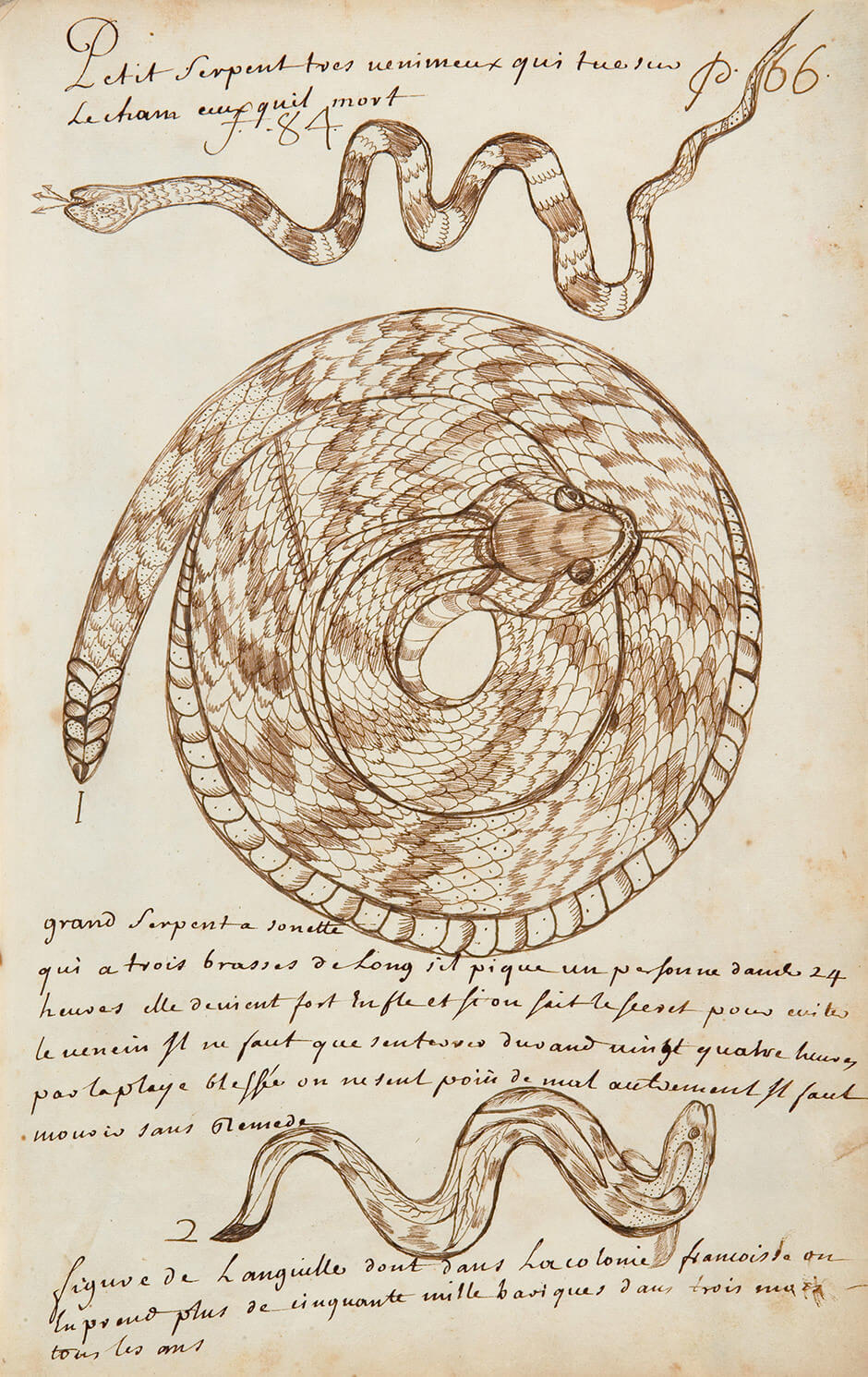
Nicolas approached his drawings of plants (18 in all), animals (67), fish (33), birds (56), and reptiles and insects (10) with care; and in classifying those he selected, he emphasized what was most useful to humans. He valued the pharmaceutical properties of certain plants and illustrated their roots, fruits, and flowers—for example the edible roots of the broadleaf arrowhead (ounonnata), which were used extensively by Indigenous peoples. The details he provides are far greater and more reliable than those in the writings of explorers such as Jacques Cartier and Samuel de Champlain or governor Pierre Boucher, author of A True and Natural History of the Customs and Productions of the Country of New France Vulgarly Called Canada (Histoire véritable et naturelle des moeurs et productions du pays de la Nouvelle-France vulgairement dite le Canada) (1664).

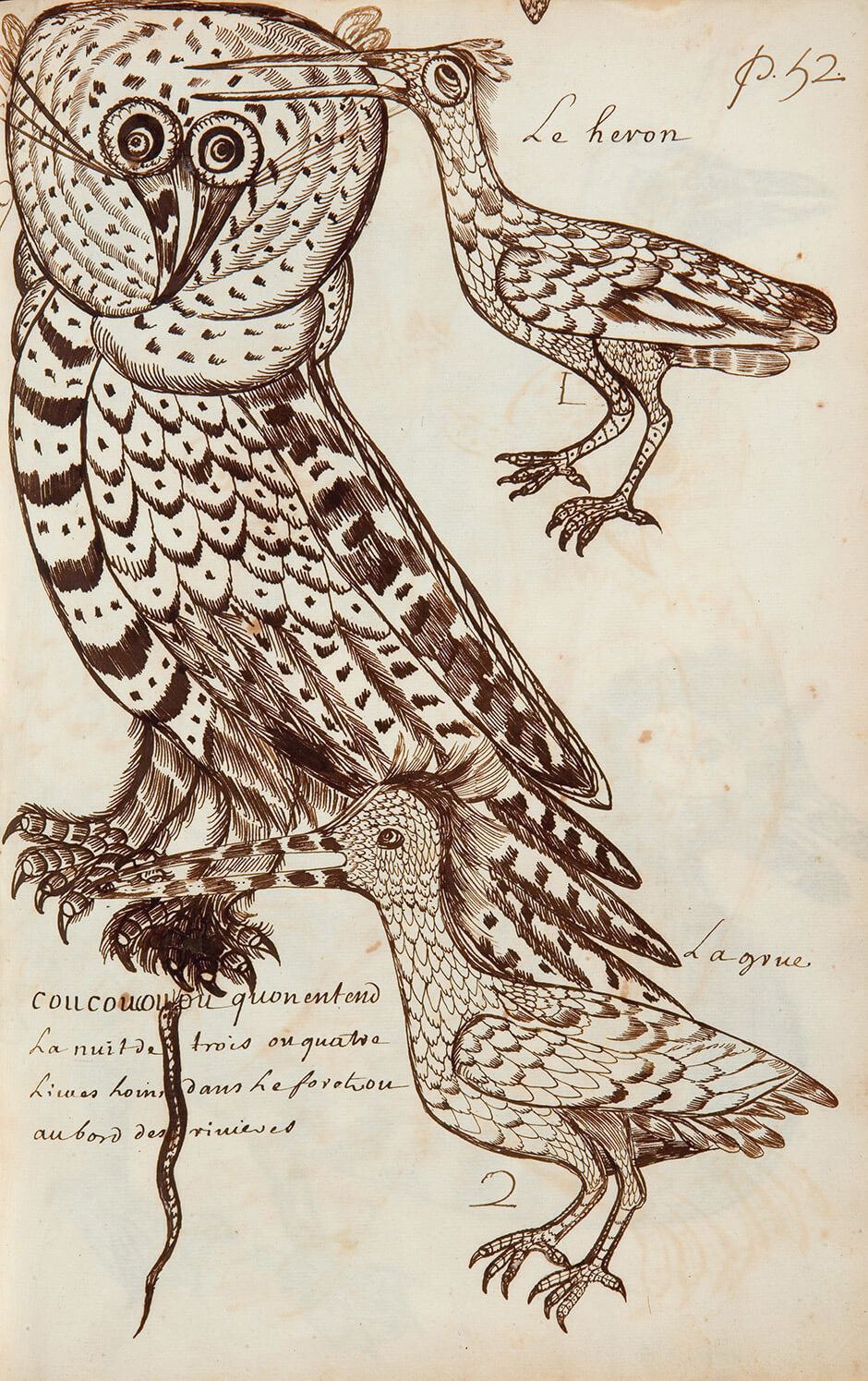
Nicolas groups his animals, fish, and birds according to size, from smallest to largest: from the mouse to the moose, the hummingbird to the owl, the white fish to the whale (for Nicolas, the whale is a fish, as are all creatures that live exclusively in water—otters, turtles, seahorses). This organizing principle is perhaps more logical than the alphabetical order used by his most famous source of inspiration, the prolific Swiss natural scientist Conrad Gessner (1516–1565), in his five-volume illustrated encyclopedia The History of Animals (Historiae Animalium) (1551–58, 1587). Nicolas’s animal images are often astonishing for their realism and individuality, as with his moose, and he depicted them from different angles and in varied poses—standing, eating, lying down. Many artists of his period had the opportunity to see only dead animals, and they portrayed them with stiff bodies and their tongues hanging out: Gessner drew his beaver that way, and Nicolas followed suit in the Codex.
The birds, too, are among the most accurate and endearing images. Nicolas drew most of them in ink only, using cross-hatching and short straight or shaped strokes effectively to catch the effect of feathers, plumed heads, and clawed feet, but some are highly coloured. The page showing owls is particularly fine. Many of these bird drawings are also remarkably accurate. At a meeting of the Society of Canadian Ornithologists in Saskatoon in October 2003, members were shown a reproduction of the opening page of the bird images in the Codex (the hummingbird, red finch, American ortolan, and others) and they easily identified the species without reading the captions.
Nicolas included two ornate and carefully drawn maps in the Codex to illustrate the large area he travelled during his time in New France. The first is a general map of the Saint Lawrence Basin—the French colonial territory in North America, including New France, Nova Scotia, New England, New York, Newfoundland, and the Great Lakes region. The second is a detailed map of “Manitounie”—the Mississippi region as explored by the Jesuit missionary Father Jacques Marquette and the French trader Louis Joliette in 1673. Like other maps produced by explorers and travellers in the seventeenth century, they show place names, rivers, and lakes. The interior map is also embellished with drawings of a rattlesnake with its tongue flicking and a Longnose gar (“chausarou”) swimming through rippling water.
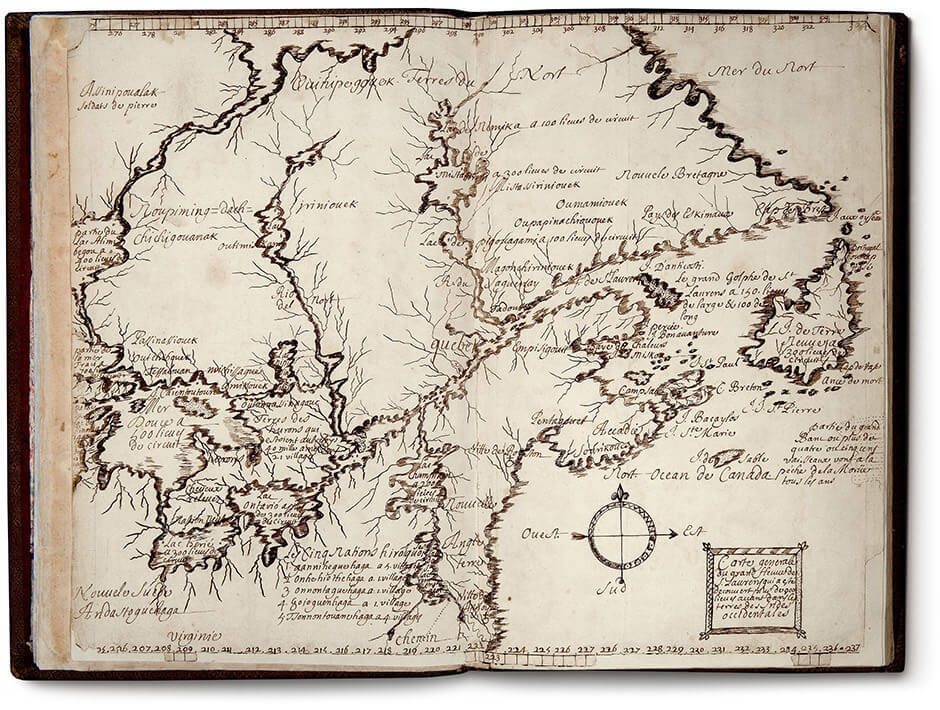
The Codex Canadensis is an unparalleled creation of its time, a work of art rare in quality and in its depictions of plants and animals. Pictorial representations from New France in the 1600s are extremely rare. For that reason alone, the detailed and accurate images of the plants and animals that Louis Nicolas created in the Codex Canadensis are invaluable.
Representations of Indigenous Peoples
The nineteen pages Nicolas devotes in the Codex Canadensis to multiple images and explanatory captions of the Indigenous peoples he met during his missionary travels provide a vital visual record of late-seventeenth-century Indigenous life. These images are not portraits, per se, but represent “types” of people Nicolas encountered; however the illustration on page 14 is of Iscouakité, a one-eyed Ottawa warrior chief who had encouraged his people “to pray.” This drawing is one of only two known portraits of Indigenous peoples created in New France.
In total, eleven different nations are depicted in the Codex. Nicolas drew their ceremonial costumes, hairstyles, pipes, tomahawks, shields, tobacco pouches, and other objects. No other illustrations from seventeenth-century North America show the body paintings of Indigenous peoples in such detail. The man from the village of Gannachiou-aé, for instance, is heavily painted and smoking a long, elaborate pipe. He has come to a neighbouring Iroquois village to invite the men to a game. The snake he holds, the “god of fire,” is even taller than he is, but as the participants dance and sing, they hold this strong serpent in their hands.
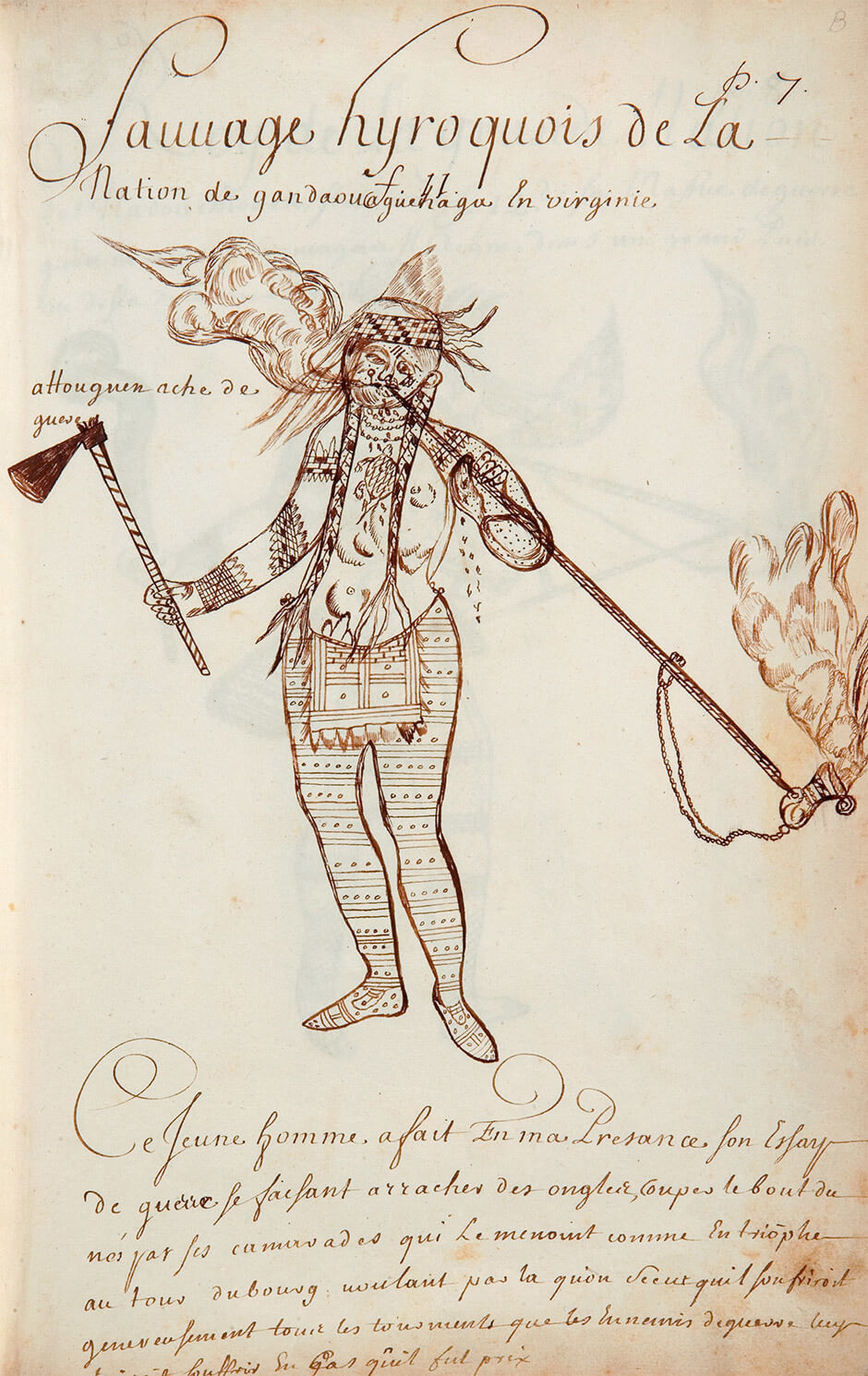
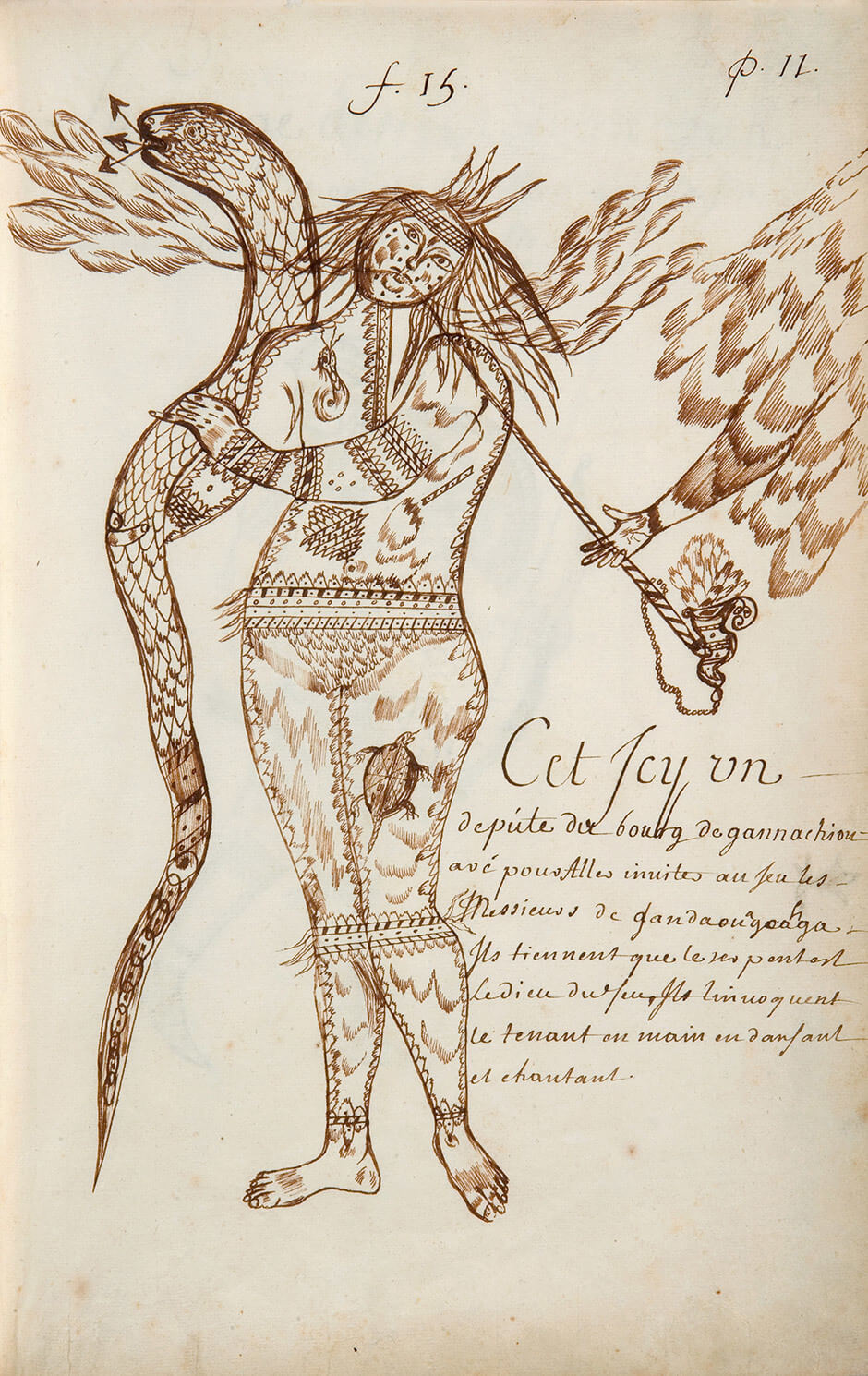
The remaining images depict several dwellings and means of transportation (snowshoes, canoes, kayak) of Indigenous peoples and a variety of fishing and fighting techniques. Unique from this period, Nicolas attempts to portray the masks worn by members of the False Face Society—an Iroquois medicine or “curing” group. He also includes the torture of a captive woman (likely a Huron), which he witnessed when he was working in Iroquois territory. Even though he would have disapproved of the longstanding and deadly rivalry between these two powerful groups (especially because the Jesuits Jean de Brébeuf and Gabriel Lalemant had been cruelly martyred at the Sainte-Marie among the Hurons Mission a few decades before), the caption for this scene is curiously devoid of judgment: “Drawing of a woman captured in war, whose nails were all pulled out with teeth. I saw her burned in the village of Toniotogéhaga for six hours during which she was slowly flayed. She was eaten partly by the Iroquois and by their dogs.”
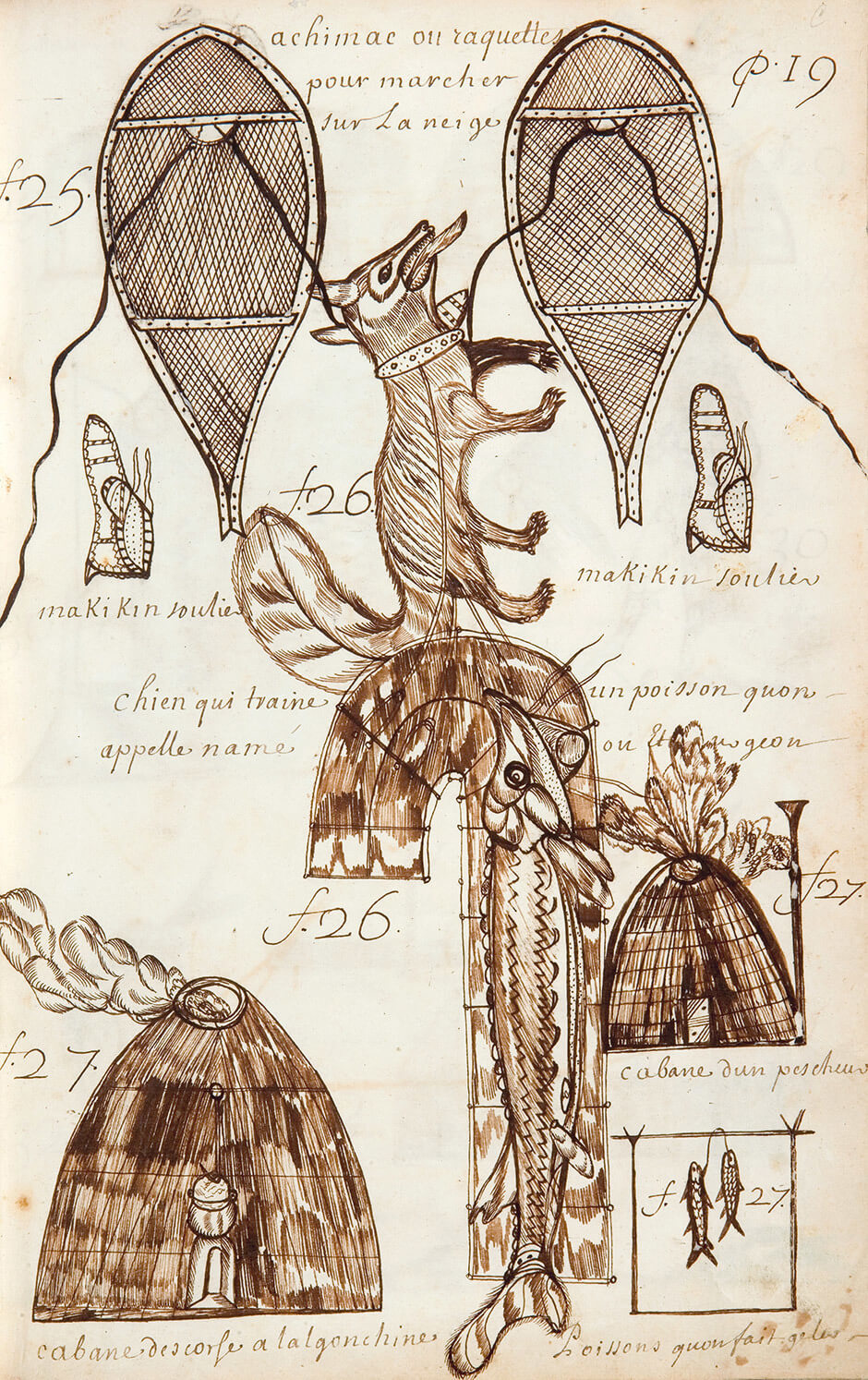

Nicolas’s depictions of the Indigenous population were influenced by the period in which he lived. Yet Nicolas seems to have appreciated the richness of the human and natural life he observed on his travels, all so different from what he knew in Europe. He packed The Natural History with information about Indigenous peoples of New France, their ways of living, and details such as their care of the sick and the medicinal plants they treasured. He described how the women used porcupine quills for decorative work. No other writer, including his superiors who assembled the reports in the Jesuit Relations (Relations des Jésuites), provided so much valuable ethnographic content about northeastern North America at this time.
Nonetheless, in The Natural History, Nicolas, like most of his contemporaries, is occasionally disparaging about the habits of the people and nations he encountered. He calls the Indigenous people “les sauvages” or “les barbares” and despised their religious rituals. Like his fellow missionaries, he was convinced that he possessed the truth and that the Indigenous peoples’ beliefs were but false inventions of the Devil. If they failed to convert, they were doomed to spend eternity in hell.
Yet he also described Indigenous peoples as “brave warriors, great hunters, entirely detached from what is servile . . . and certainly very noble, at least in their own way.” 10 How influential was Louis Nicolas in shaping views about the Indigenous people of northeastern North America? We know that he hoped The Natural History, once it was printed, would reach a wide audience of knowledgeable people of his time—and for that reason he wrote it in French, not Latin. But because it remained in manuscript form, it was probably not consulted by more than a select few. It seems that Nicolas arranged for the binding of the Codex Canadensis, and he clearly designed it for presentation to Louis XIV and a home in the Royal Library. We have no proof that it ever went there, and it seems soon to have disappeared for more than two centuries. It is unlikely, then, to have had any influence before it was published in a facsimile volume in 1930 and before the original entered the collection of the Gilcrease Museum in 1949.

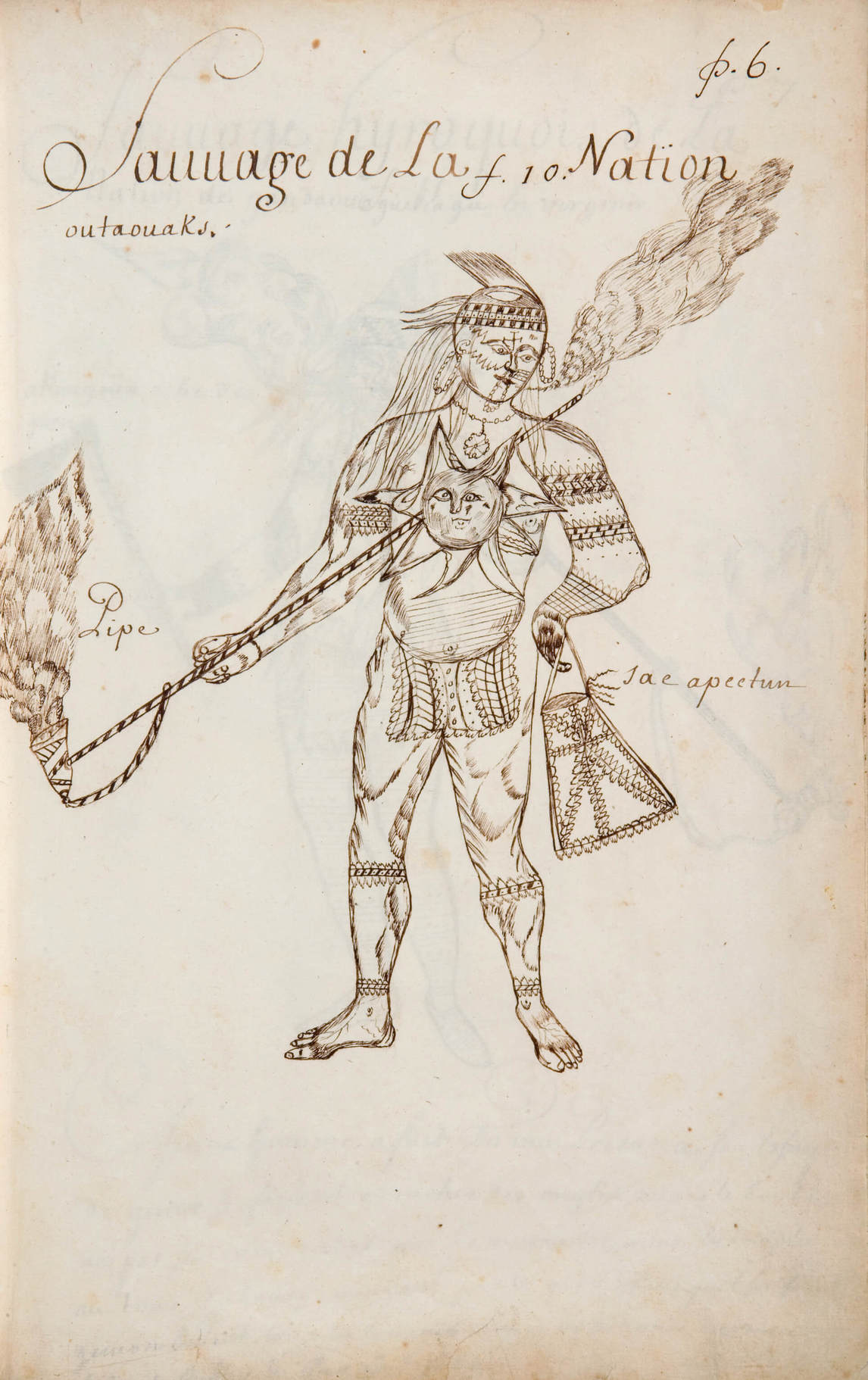

 About the Author
About the Author
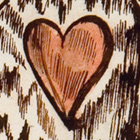 More Online Art Books
More Online Art Books
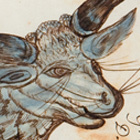 Acknowledgements
Acknowledgements